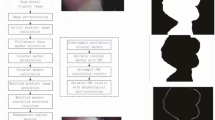Abstract
Lots of noises and heterogeneous objects with various sizes coexist in a complex image, such as an ore image; the classical image thresholding method cannot effectively distinguish between ores. To segment ore objects with various sizes simultaneously, two adaptive windows in the image were chosen for each pixel; the gray value of windows was calculated by Otsu’s threshold method. To extract the object skeleton, the definition principle of distance transformation templates was proposed. The ores linked together in a binary image were separated by distance transformation and gray reconstruction. The seed region of each object was picked up from the local maximum gray region of the reconstruction image. Starting from these seed regions, the watershed method was used to segment ore object effectively. The proposed algorithm marks and segments most objects from complex images precisely.
Similar content being viewed by others
References
J.A. Sanchidrián, P. Segarra, F. Ouchterlony, et al., On the accuracy of fragment size measurement by image analysis in combination with some distribution functions, Rock Mech. Rock Eng., 42(2009), p.95.
J. Tessier, C. Duchesne, and G. Bartolacci, A machine vision approach to on-line estimation of run-of-mine ore composition on conveyor belts, Min. Eng., 20(2007), p.1129.
T. Mäenpää and M. Pietiäinen, Classification with color and texture: jointly or separately, Pattern Recognit., 37(2004), p.1629.
H. Stephen, Texture Measures for Segmentation [Dissertation], University of Cape Town, Cape Town, 2007, p.30.
D.P. Mukherjee, Y. Potapovich, I. Levner, et al., Ore image segmentation by learning image and shape features, Pattern Recognit. Lett., 30(2009), p.615.
J. Kittler and J. Illingworth, Minimum error thresholding, Pattern Recognit., 19(1986), No.1, p.41.
N. Otsu, A threshold selection method from gray level histograms, IEEE Trans. Syst. Man Cybern., 9(1995), No.1, p.62.
M. Simphiwe, A Machine Vision-based Approach to Measuring the Size Distribution of Rocks on a Conveyor Belt [Dissertation], University of Cape Town, Cape Town, 2004, p.23.
G.Y. Zhang, G.Z. Liu, H. Zhu, and B. Qiu, Ore image thresholding using bi-neighborhood Otsu’s approach, Electron. Lett., 46(2010), p.1666.
E.R. Davies and A.P.N. Plummer, Thinning algorithms: a critique and a new methodology, Pattern Recognit., 14(1981), p.53.
P.J. Toivanen, New geodesic distance transforms for gray-scale images, Pattern Recognit. Lett., 17(1996), No.5, p.437.
S. Svensson and G. Sanniti Di Baja, Using distance transforms to decompose 3D discrete objects, Image Vision Comput., 20(2002), No.8, p.529.
G.Y. Zhang and Y. Sha, Object Segmentation and Recognition of Mining, Petroleum Industry Press, Beijing, 2010, p.69.
C. Snehamoy, B. Ashis, S. Biswajit, et al., Rock-type classification of an iron ore deposit using digital image analysis technique, Int. J. Min. Miner. Eng., 1(2008), No.1, p.22.
I. Levner and H. Zhang, Classification-driven watershed segmentation, IEEE Trans. Image Process., 16(2007), No.5, p.1437.
L. Vincent and P. Soille, Watersheds in digital spaces: an efficient algorithm based on immersion simulations, IEEE Trans. Pattern Anal. Mach. Intell., 13(1991), No.6, p.583.
Author information
Authors and Affiliations
Corresponding author
Additional information
The work was financially supported by the National Key Technologies R & D Program of China (No.2009BAB48B02) and the National High-Tech Research and Development Program of China (Nos.2010AA060278600 and 2008AA062101).
Rights and permissions
About this article
Cite this article
Zhang, Gy., Liu, Gz. & Zhu, H. Segmentation algorithm of complex ore images based on templates transformation and reconstruction. Int J Miner Metall Mater 18, 385–389 (2011). https://doi.org/10.1007/s12613-011-0451-8
Received:
Revised:
Accepted:
Published:
Issue Date:
DOI: https://doi.org/10.1007/s12613-011-0451-8




